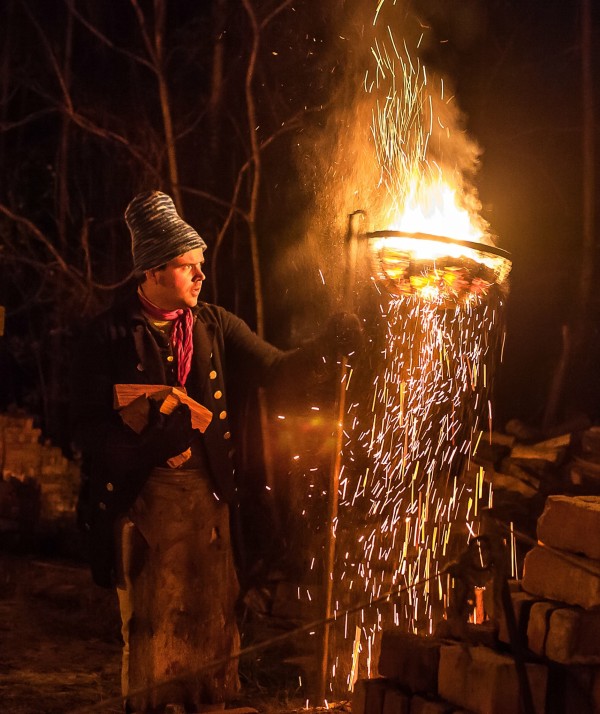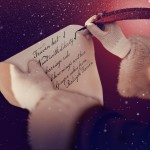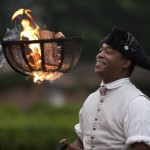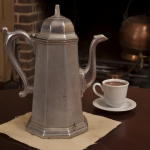
Fatwood is my favorite mood-altering substance. When the days get short and the nights cool in Williamsburg, it burns in cressets all over town, offering heat and light, but also kindling our spirits.
Fires soften the approach of winter. Here, they beckon visitors to trade shops and taverns, and draw clusters of warmth-seekers. But there’s a lot of work that goes into getting the pretty fires into the six-foot high baskets.
The Cresset Crew (worthy of capitalization, in my book) works odd hours all year long to light the town. At this time of year there are fires burning every night. You’ll find members of the team carrying torches at a Fifes and Drums march on Duke of Gloucester St., stocking the piles of wood near the cressets, or tending the fire at an evening program.
But most of the prep work is done early in the morning. The Crew numbers about 25 people. Most work in one of Colonial Williamsburg’s Historic Trades. On the day I visit there are perhaps a dozen at work behind the Grissell Hay House on Nicholson St.
They assemble at 7 a.m. Some are in costume, since they’ll be headed to their Historic Area posts shortly after the firewood shift. Others wear jeans or Carhartts.
Most sit in a semi-circle near a high pile of fatwood under a tarp. The pile grows through the year as the wood is prepared in warmer weather, then dwindles as it used for nightly programs in Autumn and Winter. At the moment it’s about five feet high.
Crew members use hatchets to cut the fatwood into different sizes, depending on how they want it to burn. Thinner pieces burn bright and hot, but also fast. They only last 15 or 20 minutes. Thicker pieces will burn for half an hour or so.
Crewmembers chew the fat as they chop the fatwood into smaller pieces and load it into large cloth sacks. Particularly interesting pieces of knotted wood get hung from the tree overhead, an inside joke that makes for bizarre ornamentation.
Fatwood is what folks around here call the resin-rich wood from pine trees. It burns really well because it’s saturated with sap. Colonial Williamsburg has purchased its annual supply from Wood Products International, a family-owned company in Georgia, for more than 20 years. The wood is harvested in Honduras.
It comes in two different sizes. A ton—literally, 2,000 pounds—of 8-inch sticks for starting the fires was recently ordered. That’s in addition to the typical year’s supply of about 21,000 larger fatwood blocks.
The door of the garage tilts upward to reveal a space filled with dry wood, fuel, tools, and other necessary supplies. The “fatcave,” as one person refers to it.
Journeyman silversmith Preston Jones has been in charge of the Crew for more than 20 years. He calls out for a few volunteers to hop into the horseless carriage—ok, it’s a truck—and help with the morning’s route.
Scanning his list of upcoming and just-over performances, he calculates how many sacks of fatwood they’ll need this morning.
The truck rumbles through town alongside early morning joggers, dog-walkers, and maintenance staff, making stops wherever cressets were burning the day or two before. If the program is over, they dump the ash in a trash can on the truck and collect the cressets.
Recurring programs—and this year, the ice skating rink—receive a fresh supply of fatwood. Preston tells crew members to leave a dozen bags. There needs to be a large supply for the cressets around the rink as well as the two fire pits at the nearby picnic tables. A large pile takes shape behind Liberty’s Eats and Treats.
By 8 a.m. the morning rounds are over and the crew scatters to work, breakfast, or a day off. But some will be back by nightfall.
It may seem that no one is around in the evening when the cressets have been lit, but there’s usually a member of the cresset crew lurking nearby. They light the cressets at dusk, around 5 p.m. this time of year, using a sawdust and kerosene mixture to quickly start the fire, although the highly flammable fatwood doesn’t need too much encouragement.
They stick around to tend the fire, making sure that no one does anything crazy and that the basket is regularly resupplied.
If you’re feeling adventurous, and want to bring some of that Colonial Williamsburg atmosphere home, you can purchase your own cressets, which you can order online direct from Colonial Williamsburg. The hand-forged set includes the basket and pole, and it’s made in the USA.
They are also available in our stores: Celebrations; Colonial Nursery; Tarpley, Thompson & Company; Prentis; and Greenhow. If you’re in town visiting and want to purchase a cresset, we’ll even ship it to your house for a small fee. Just ask the cashier at checkout!
(Just make sure it’s ok with your homeowner’s association!)
Special thanks to Chuck Durfor and Rob Hunter for their photo contributions!



Can anyone tell me why the cressets that are used in CW hang from the poles and the ones you purchase sit on top of the post?
It’s great that you are getting ideas from this post as well as from our dialogue made at this time.
We just arrive home from a week in Williamsburg, VA. What a treasure we have in this beautiful place. The Cressets were lit only when the nighttime temp was low enough to enjoy them. Walking down Duke of Gloucester after sunset was such an enjoyment with the fires burning. Thank you for the experience. We WILL be back (from TN) next year.
Very interesting, Bill. When I lived in Florida, I learned that local folks called the resin-soaked wood at the heart of pine trees “lighter knot,” because it could be used to start fires. They were right.
Gosh, I wish I lived closer…I just had 3 humongous pine trees cut down in my front yard today. They would have fueled your cressets for several nights.